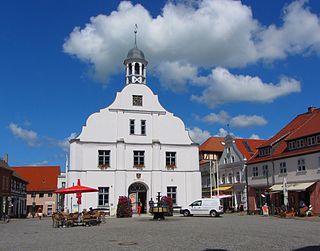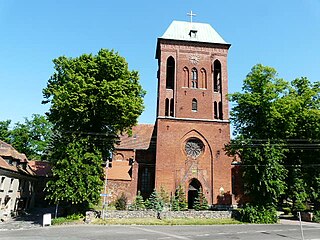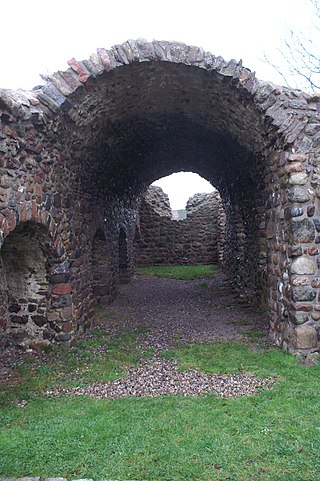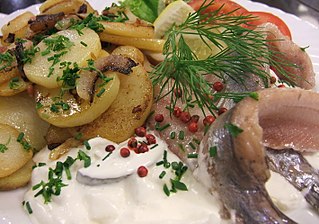
Usedom is a Baltic Sea island in Pomerania, divided between Germany and Poland. It is the second largest Pomeranian island after Rügen, and the most populous island in the Baltic Sea.

Swedish Pomerania was a dominion under the Swedish Crown from 1630 to 1815 on what is now the Baltic coast of Germany and Poland. Following the Polish War and the Thirty Years' War, Sweden held extensive control over the lands on the southern Baltic coast, including Pomerania and parts of Livonia and Prussia.

The Duchy of Pomerania was a duchy in Pomerania on the southern coast of the Baltic Sea, ruled by dukes of the House of Pomerania (Griffins). The country existed in the Middle Ages between years 1121–1160, 1264–1295, 1478–1531, and 1625–1637.

Wolgast is a town in the district of Vorpommern-Greifswald, in Mecklenburg-Vorpommern, Germany. It is situated on the bank of the river Peenestrom, vis-a-vis the island of Usedom on the Baltic coast that can be accessed by road and railway via a movable bascule bridge. In December 2004, the town had a population of 12,725.

Usedom is a town on Usedom Island, in the Vorpommern-Greifswald district in Mecklenburg-Vorpommern, in north-eastern Germany, close to the border with Poland. It is the seat of the Amt Usedom-Süd, to which 14 other communities also belong.

Pudagla is a municipality in the Vorpommern-Greifswald district, in Mecklenburg-Vorpommern, Germany.

The Bishopric of Cammin was both a former Roman Catholic diocese in the Duchy of Pomerania from 1140 to 1544, and a secular territory of the Holy Roman Empire (Prince-Bishopric) in the Kołobrzeg area from 1248 to 1650.
The County of Gützkow was a county located within the Duchy of Pomerania in the High Middle Ages. It was established in 1129 from the Castellany of Gützkow. Following the death of its last count in 1359, it was re-established into the Vogtei Gützkow.

Stolpe Abbey was the first monastery in Pomerania. It was located on the southern bank of the Peene River between Gützkow and Anklam near the village of Stolpe an der Peene.
Adalbert of Pomerania was the first bishop of the 12th century Pomeranian bishopric, with its see in Wolin. He was a monk of the Michaelsberg Abbey, Bamberg and former chaplain to Bolesław III Wrymouth of Poland, whence he knew the Pomeranian language of the temporarily Polish-subjugated West Slavic population, whereas the Joms Vikings and other Germanic inhabitants of the Pomeranian coast understood his old German language.

Pomerania during the High Middle Ages covers the history of Pomerania in the 12th and 13th centuries.

History of Pomerania (1945–present) covers the history of Pomerania during World War II aftermath, the Communist and since 1989 Democratic era.
Medieval Pomerania was converted from Slavic paganism to Christianity by Otto of Bamberg in 1124 and 1128, and in 1168 by Absalon.

Groswin was the name-giving seat of one of the castellanies of the Duchy of Pomerania in the High Middle Ages. It was located in Western Pomerania near modern Anklam.

Ernst Ludwig was duke of Pomerania from 1560 to 1592. From 1569 to 1592, he was duke in the Teilherzogtum Pomerania-Wolgast, sharing the rule over the Duchy of Pomerania with his older brother Johann Friedrich, duke in the other Teilherzogtum Pomerania-Stettin and bishop of Cammin.

Philipp Julius was duke of Pomerania in the Teilherzogtum Pomerania-Wolgast from 1592 to 1625.

The Treaty of Grimnitz was the final settlement of a long-standing dispute between the House of Pomerania and the House of Hohenzollern regarding the legal status and succession in the Duchy of Pomerania. It renewed and amended the Treaty of Pyritz of 1493.

Veste Landskron or Lanzkron is a Renaissance water castle in the municipality Neuendorf B, Vorpommern-Greifswald district, Mecklenburg-Vorpommern, Germany. Built between 1576 and 1579, it deteriorated in the 17th century. Its ruins are a tourist attraction and frequently the site of cultural events.

Maria of Saxony was a member of the Ernestine line of the house Wettin and a Princess of Saxony by birth and by marriage a Duchess of Pomerania.

Pomeranian cuisine generally refers to dishes typical of the area that once formed the historic Province of Pomerania in northeast Germany and which included Stettin and Further Pomerania. It is characterised by ingredients produced by Pomeranian farms, such as swede (Wruken) and sugar beet, by poultry rearing, which has produced the famous Pomeranian goose, by the wealth of fish in the Baltic Sea, rivers and inland lakes of the Pomeranian Lake District, and the abundance of quarry in Pomeranian forests. Pomeranian cuisine is hearty. Several foodstuffs have a particularly important role to play here in the region: potatoes, known as Tüften, prepared in various ways and whose significance is evinced by the existence of a West Pomeranian Potato Museum, Grünkohl and sweet and sour dishes produced, for example, by baking fruit.

















